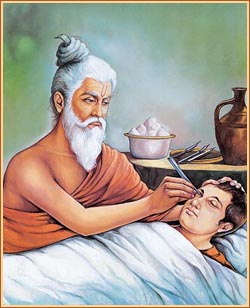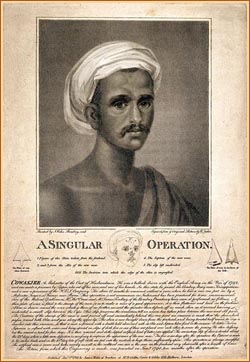| |

Sushrut compiled the knowledge and teachings of his guru Divodas Dhanvantari,
King of Kashi, in the Sushrut Samhita. It was common for surgeons
then to be associated with kings, as has been cited in the Rg Veda,
Mahabharat, Sushrut Samhita and Kautilya’s Arthashastra. Sushrut
and his descendants are said to pre–date Panini, the great Sanskrit
grammarian. Patanjali in his Mahabhashya and Katyayan in the Varttika
also mention Sushrut. However scholars ascribe Sushrut’s true
period to 1000 BCE (Sharma 1999: 87).
During his era, surgery formed a major role in general medical training.
It was known as Shalya–tantra – Shalya means broken arrow
or sharp part of a weapon, and tantra means manoeuvre. Since warfare
was common then, the injuries sustained led to the development of
surgery as a refined scientific skill.
Apart from being a treatise primarily on surgery, the Sushrut Samhita
encompasses the other seven Ayurvedic faculties. Sushrut also details
surgical procedures in other specialised branches which warrant surgery,
such as obstetrics, orthopaedics and ophthalmology. To consider an
example of the latter, he describes a method of removing cataract,
known today as ‘couching’. This was routinely practised
by Ayurvedic surgeons in India over the ages until the late half of
the twentieth century. For successful surgery Sushrut induced anaesthesia
using intoxicants such as wine and henbane (Cannabis indica). This
led A.O. Whipple in his Story of Wound Healing (1965), to comment,
must be accepted as a pioneer in some form of anaesthesia.”
The depth of his expositions in such a variety of faculties reflects
his brilliance and versatility. He asserted that unless the surgeon
possessed knowledge of the related branches, he does not attain proficiency
in his own field.
Like his guru Dhanvantari, Sushrut too, considered the knowledge of
anatomy obligatory for a surgeon to be skilled in his art. This necessitated
dissecting cadavers. Alongwith anatomy, Sushrut gives details of human
embryology in Sharirsthan, which are mind–boggling. This is
all the more astounding when we bear in mind that such detailed observation
is today only possible using microscopy, ultrasonography and X–rays.
To cite just one example, he mentions that the foetus develops seven
layers of skin, naming each layer and the specific diseases which
may affect that layer in adult life! (Sharirsthan IV–3). He
was also aware of diseases by genetic inheritance. He mentions many
congenital defects acquired from parents and those resulting from
indulgences of the mother during pregnancy. Therefore he advises her
to avoid exertion for the perfect development of the foetus. For instance,
she should avoid physical exertion, daytime sleep, keeping awake late
into the night, extreme fasting, fear, purgatives, travelling on a
vehicle, phlebotomy and delaying the calls of nature (Sharirsthan
III.11).
Sushrut’s era, as all down the ages, involved warfare. This
meant injury from weapons such as arrows often embedding as splinters
– shalya. He has categorised two types of symptoms for splinters
– general and specific – from which a diagnosis can be
made, of the type of splinter and its exact depth. He further details
the different symptoms for different splinters of bone, wood, metal
embedded in skin, muscle, bones, joints, ducts, pipes or tubes. He
then prescribes fifteen different procedures for removing loose splinters.
Two notable methods for problematic splinters though seemingly extreme,
are highly effective and innovative. If a splinter is lodged in a
bone and fails to budge, its shaft should be bent and tied with bowstrings.
The strings should be tied to the bit of the bridle of a tame horse.
While holding the patient down, the horse should be slapped or hit
with a stick so that it jerks its head. In doing so, the splinter
is forced out! If that fails, one could pull down a strong branch
of a tree and tie the splinter to it. One then lets go of the strained
branch, which will draw out the splinter!
Besides splinter injuries, Sushrut also deals with trauma. He describes
six varieties of accidental injuries encompassing almost all parts
of the body:
-
Chinna: Complete
severance of a part or whole of a limb
-
Bhinna: Deep
injury to some hollow region by a long piercing object
-
Viddha prana:
Puncturing a structure without a hollow
-
Kshata: Uneven
injuries with signs of both chinna and bhinna, i.e.
a laceration
-
Pichchita:
Crushed injury due to a fall or blow
-
Ghrsta: Superficial
abrasion of the skin
Besides trauma involving general surgery,
Sushrut gives an in–depth account and treatment of twelve varieties
of fractures and six types of dislocations, which would confound orthopaedic
surgeons today. He mentions principles of traction, manipulation, apposition
and stabilisation, as well as post–operative physiotherapy!
Being a genius and a perfectionist in all aspects of surgery he even
attached great importance to a seemingly insignificant factor such as
scars after healing. He implored surgeons to achieve perfect healing,
characterised by the absence of any elevation or induration, swelling
or mass, and the return of normal colouring. He went as far as prescribing
ointments to achieve this, managing to change healed wounds from black
to white and vice versa!
He also prescribed measures to induce growth of lost hair and to remove
unwanted hair. Such minute detailing reflects his deep insight, rendering
him the first surgeon in world history to practice a holistic approach
in treating surgical patients. According to Sankaran and Deshpande,
“No single surgeon in the history of science has to his credit
such masterly contributions in terms of basic classification, thoroughness
of the management of disease and perfect understanding of the ideals
to be achieved” (1976:69). To Sushrut health was not only a state
of physical well–being, but also mental, brought about and preserved
by the maintenance of balanced humours, good nutrition, proper elimination
of wastes and a pleasant, contented state of the body and mind.
Finally, from the patient to the surgeon. He gave a definition of an
ideal surgeon embodying all possible requisites, which has yet to be
improved upon even today. “He is a good surgeon,” he declares,
“who possesses courage and presence of mind, a hand free from
perspiration, tremorless grip of sharp and good instruments and who
carries his operations to success and the advantage of his patient who
has entrusted his life to the surgeon. The surgeon should respect this
absolute surrender and treat his patient as his own son.”
Sushrut’s excellence in surgery and original insights in all branches
of medicine render him the most versatile genius in the history of medical
science. His contributions have withstood the test of over three thousand
years. In the absence of sophisticated instruments available to us today,
his profound observations then may be attributed to two factors: grace
of a stalwart guru, Dhanvantari, and divine revelation through personal
sadhana – meditation. These observations of an ancient rishi,
today continue to intrigue researchers at the Wellcome Institute of
the History of Medicine in London and other similar institutions in
Europe, USA and India.
Reconstructive Surgery in India
In 1792 Tippu Sultan’s soldiers captured a Maratha cart–driver
named Cowasjee (Kawasji) in the British army and cut of his nose and
an arm. A year later, a kumbhar (potter) vaidya in Puna reconstructed
Kawasji’s nose. Two British surgeons in the Bombay Presidency,
Thomas Cruso and James Findlay witnessed this skilful procedure and
noted the details. In October 1794, this account was published in
The Gentleman’s Magazine of London, describing it as an operation
‘not uncommon in India and has been practiced for time immemorial’!
This procedure, similar to that cited in the Sushrut Samhita, ultimately
changed the course of plastic surgery in Europe and the world. It
was different from Sushrut’s, in that Kawasji’s graft
was taken from his forehead. Sushrut grafted skin from the cheek.
To aid healing, he prescribed the use of three herbs and cotton wool
soaked with sesame seed oil in dressing the graft. After the graft
healed, he advocated cutting off the tissue joined to the cheek (Sutrasthan
16/18).
Regarding cosmetic surgery, Sushrut could also reconstruct ear lobes
and enumerates fifteen ways in which to repair them. Guido Majno in
The Healing Hand: Man and Wound in the Ancient World (1975), notes
that, “Through the habit of stretching their earlobes, the Indians
became masters in a branch of surgery that Europe ignored for another
two thousand years.” Sushrut meticulously details the pre–and
post–operative procedures. After stitching, for example, he
prescribes dressing the lobe by applying honey and ghee, then covering
with cotton and gauze and finally binding with a thread, neither too
tightly nor too loosely. Torn lips were also treated in a similar
manner (Sutrasthan 16/2–7, 18, 19).
Sadhu
Mukundcharandas
|
|





